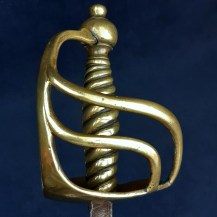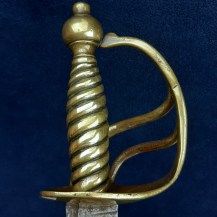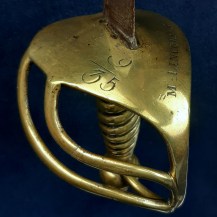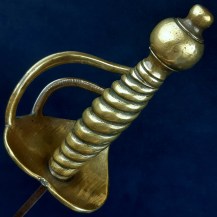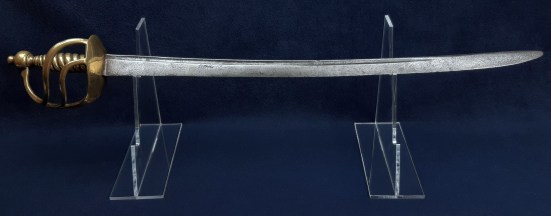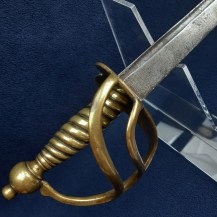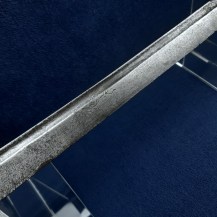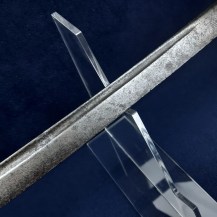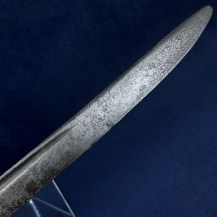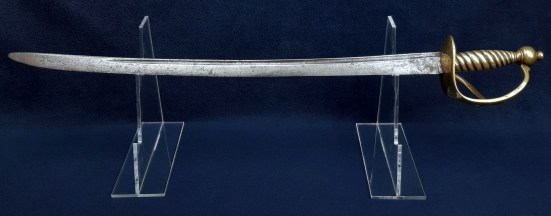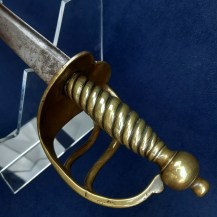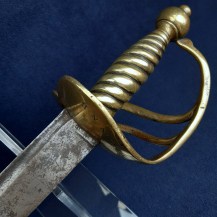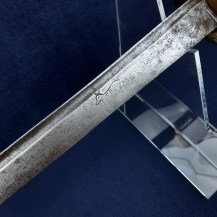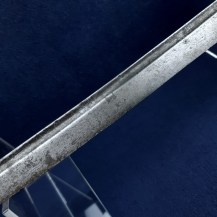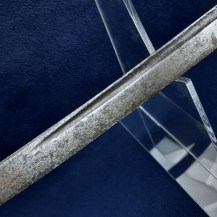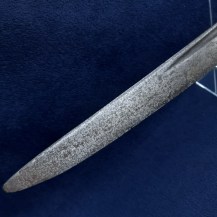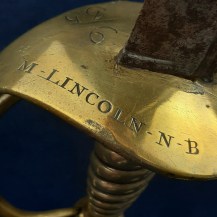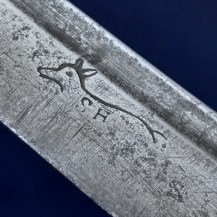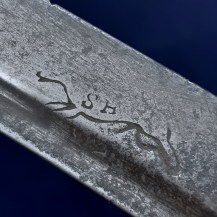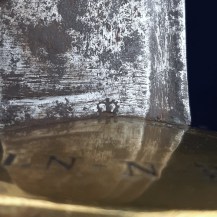English 1751 Pattern Infantry Hanger, North Lincoln Militia, by Samuel Harvey
Slightly curved hanger blade with hatchet point, single narrow fuller close to the spine. Cast brass heart-shaped hilt with two side bars, spiral grip and round pommel. No scabbard. Blade length ~24¾ inches (62.8cm), the sword ~30½ inches (77.5cm) overall.
The outside of the hilt is engraved with ‘M – LINCOLN – N – B’, indicating issue to the North Battalion of Lincolnshire Militia, aka the North Lincoln Militia and ‘4 / 34’, most likely a rack number. The blade is stamped on both sides with a running fox within which are the initials ‘SH’, indicating the maker Samuel Harvey. It is also stamped at the shoulder on one side with a crown mark, partly obscured by the hilt. This indicates government inspection or ownership and suggests this was part of an officially ordered production run.
The ‘1751 Pattern’ is not an official pattern of British sword (built to specifications set by the military establishment) but a widely used type that appeared around that date, was purchased officially to some degree and issued to many regiments. In this era colonels of regiments typically controlled procurement of equipment but market availability affected their choices and some larger-scale ordering took place. The 1751 is simple and durable, its blade typical of the British ‘hanger’, and survives in some numbers today considering its age. Almost all examples are marked to a militia unit.
The North Lincoln Militia was first raised in 1759, one of many created by the Militia Act of 1757 to respond to the threat posed by France during the Seven Years War. Parish constables drew up lists of all men aged 18 – 50, with limited exemptions, then drew ballots to select some for three years of compulsory militia service, although men chosen could delegate their role to paid substitutes if they could find & afford them. The county of Lincolnshire had two separate battalions, North and South.
Militia units were for home defence only, and could not be sent overseas – service in practice meant a few weeks of training each year and occasional mustering for duty in keeping public order, almost always outside their home county. Nonetheless, the compulsory system was unpopular and riots broke out in Lincolnshire in 1757 over the Bill’s passage, some wrongly believing that it meant they would be conscripted into fighting overseas. Several counties delayed implementing the changes for years for fear of similar civil unrest.
The Childers Reforms of 1881 attached county militia units to their respective county’s regiments as their third or fourth battalions – the North Lincoln Militia accordingly became the 3rd Battalion, Lincolnshire Regiment. This battalion served overseas for the first time in the Boer War. In 1908 all Militia battalions became the Special Reserve. It served as a training unit throughout WW1 supplying trained men to the regular battalions. The 3rd Battalion was disbanded in 1953 as the regiment shrank in size - after a series of amalgamations the lineage of the Royal Lincolnshire Regiment is today maintained by the Royal Anglian Regiment.
The firm of Samuel Harvey was established in 1748, and used the mark of the ‘running fox’ on both sides of their sword blades. After Samuel’s death in 1778 the family business was continued by his son and grandson, both of the same name, the last of whom died in 1810.
The blade has been sharpened, with numerous nicks to its edge and a rounded tip. It has patches of patination and some spots of light pitting, with heavier pitting at the very tip. The brass hilt and grip are in good condition with even light patination and a few dents. The outer bar has a crack where it joins to the hilt but this is surface-level, it does not run all the way through the bar. The short quillon usually found on this type appears to have been deliberately removed. Slight movement of the hilt side to side, while the grip remains firm.


